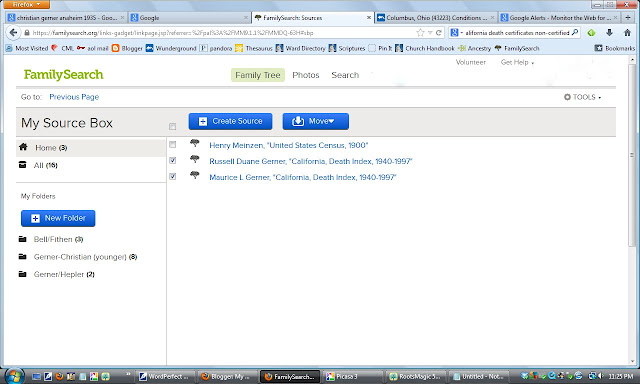While waiting for obituaries for Alfred and Emma Gerner Vensel to arrive from the
Butler Area Public Library Obituary Index I decided to see if I could find Emma's brother, Christian. The 1860, 1870, and 1880 U.S. Census records for their father, Christian Gerner/Garner/Gardner, indicate that his fifth child and third son is
Christian Gerner, born about 1854. My great-grandfather, Fred Gerner, is likely the brother of Emma and Christian. Below are overviews of the records I found for a man named Christian Gerner who was born in Pennsylvania in 1854.
As far as I can see, through marriage, census, and death records, the names and ages follow along almost exactly. The only obvious discrepancy is Christian's month of birth, stated as July on his marriage record and June in the 1900 census. I believe this is the son of Christian and the brother of my great-grandfather Fred Gerner. I plan to order a death certificate for Christian and hope to find obituaries for Christian and Amanda/Mandy in
Google newspapers.
-marriage-AmandaDaubenspeck1886.jpg) Marriage
Marriage, 22 October 1886, Butler County, Pennsylvania
Christian Gerner, born on 12 July 1854, in Clarion County, Pennsylvania
residing in Washington, Washington County, Pennsylvania, occupation was Driller
and
Amanda Daubenspeck, born on May 16, 1858, in Armstrong County, Pennsylvania
residing in Clarion County, Pennsylvania
1900 U.S. Census, North Franklin Township, South Washington Borough, Washington County, Penna., E.D. 148, sheet #5, page #238A, family #75, lines 14-17
- Christian Gerner, born June 1854, 45 years old, married 13 years, born Penna, parents born Germany, oil pumper
- Amanda Gerner, wife, born May 1858, 42 years, married 13 years, born Penna, parents born Penna
- Maurice L. Gerner, son, born January 1890, 10 years, born Penna, parents born Penna
- Russel D. Gerner, son, born Jul 1892, 7 years, born Penna, parents born Penna
1910 U. S. Census, McKim Disrict, Pleasants County, West Virginia, E. D. 62, Sheet #8B, family #140, lines 70-73
- Gerner Christian, 55 years, married 24 years, born Penna, parents born Germany, pumper/oil lease
- -------- Amanda, wife, 51 years, married 24 years, born Penna, parents born Penna
- -------- Morris L, son, 20 years, single, born Penna, parents born Penna, pumper/oil lease
- -------- Russell D, son, 17 years, single, born Penna, parents born Penna
1920 U.S. Census, Anaheim City, Anaheim Township, Orange County, California, E.D. 52, sheet #6A, page #163, family #144, lines 11-13
- Gerner Christian, 65 years, born Penna, parents born Germany, no trade/profession
- -------- Amanda J, wife, 61 years, born Penna, parents born Penna
- -------- Russell, son, 27 years, single, born Penna, parents born Penna, no trade/profession
1930 U.S. Census, Anaheim City, Orange County, California, E. D. #20-1, written sheet #5A, page #5, family #115, lines 31-34
- Gerner Christen, 75 years, 32 years at first marriage, born Penna, parents born Germany, retired
- -------- Mandy J, wife, 71 years, 28 years at first marriage, born Penna, parents born Penna
- -------- Morris L, son, 40 years, divorced, 21 years at first marriage, born Penna, parents born Penna, oil driller/oil field
- -------- Russell D, son, 37 years, single, born Penna, parents born Penna, oil driller/oil field
1940 U.S. Census, Anaheim City, Orange County, California, E.D. 30-2, sheet 316A, household #428, lines 38-39
- Gerner Maurice L, head, 50 years, divorced, born Penna, oil worker/fields
- -------- Amanda, mother, 81 years, widow, born Penna
The 1940 census indicates that Christian died between 1930 and 1940. I searched the
California Death Index, 1905-1939 and learned that Christian died on October 9, 1935. For Amanda's death information I search the
California Death Index, 1940-1997, also at FamilySearch and learned that she died on July 22, 1953.
I hope that Christian's death certificate will give his parents' names and that an obituary might contribute even more information. I just have to order one and find the other. (I especially wish that California death certificates were available free online somewhere.)
--Nancy.
.
 I was a little surprised when I read the Google Reader sign-in screen yesterday. It asked me if I was having trouble keeping up with the sites I visit. If so, it told me, I could read them in one place, at Google Reader, where keeping up with my favorite websites is as easy as checking my email. It offered me the opportunity to use Reader to stay up to date, to share with my friends, and use anywhere. (You can click on the image to enlarge it and read for yourself.)
I was a little surprised when I read the Google Reader sign-in screen yesterday. It asked me if I was having trouble keeping up with the sites I visit. If so, it told me, I could read them in one place, at Google Reader, where keeping up with my favorite websites is as easy as checking my email. It offered me the opportunity to use Reader to stay up to date, to share with my friends, and use anywhere. (You can click on the image to enlarge it and read for yourself.)


















-ButlerCitizen1906-04-12.jpg)
-ParkerPhoenix1906-04-13.jpg)









-marriage-AmandaDaubenspeck1886.jpg)








